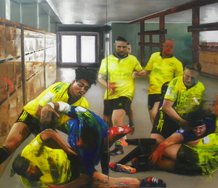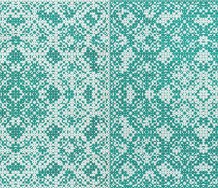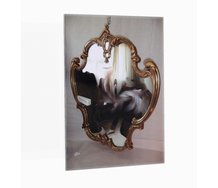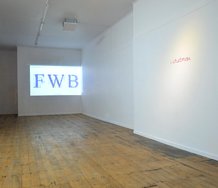Sophie Violet Gilmore – 18 March, 2014
In his gravity-defying collection of noodle bowl sculptures, noodles dangle from chopsticks suspended in mid-air, contemplating the way that vision can activate the other senses in an imaginary capacity. Steam seems to rise from the liquid base of each sculpture, and the noodles convey a vivid sense of slipperyness. These works, funny and disquieting bring new meaning to the idea of a “still life”.
I’ve never understood why the Dunedin Public Gallery has such an enormous foyer and comparatively narrow gallery spaces, but over the years curators and artists have been negotiating this weird configuration in creative and practical ways. One of the most exciting exhibitions there has to be Seung Yul Oh’s Moamoa, a joint project with City Gallery Wellington. This artist, when tasked with the challenge of creating a work specifically for the monumental upstairs side wall of this unwieldy space, has simply and confidently placed stripes of colour across its edges and middle. The piece is reminiscent of Mondrian’s colour grids, but somehow lighter because of its massive scale. The white of the walls, left unaffected in the spaces inside the colour, takes on more personality than the empty backdrop that we come to expect from a gallery space. Yet beneath the thought-provoking transformation is humour and sharp irony.
The works of this Korean New Zealander are concerned with cultural pecularity, globalisation, the absurdities of consumerism and the urban experience. What makes Oh so interesting is the energetic way in which he brings a range of multimedia approaches to these concerns. Moamoa encompasses video art, painting, and different types of sculpture, some of which exist as a peculiar visual experience, creating an impalpable barrier between the viewer and them despite their shaped space. In his gravity-defying collection of noodle bowl sculptures, which have titles such as Ra Myun, noodles dangle from chopsticks suspended in mid-air, contemplating the way that vision can activate the other senses in an imaginary capacity. Steam seems to rise from the liquid base of each sculpture, and the noodles convey a vivid sense of slipperyness. These works, funny and disquieting (and appetizing or unappetizing depending on preference) bring new meaning to the idea of a “still life”.
Other sculptures dramatically reconfigure the spaces they are placed in, making physical interaction with them irresistable. One of these, Periphery is a forest of giant pill-shaped PVC obstructions. When wading through the space it is impossible to avoid colliding with them. At times they seem on the verge of collapsing, and the neutral coloured, light-sapping space they are enclosed in becomes more and more disorientating - until you hurtle unexpectedly back into the gallery. Following on from Periphery is Square Sphere, a kind of huge, communal bean bag for everyone, surrounded by three dreary, dreamy video installations. The greyness of this bouncy sculpture seems to absorb you into its depth, the shifting peaks of the bean-bag are impossible to climb, and raucous laughter echoes through the gallery. This work, cetainly the most memorable of the exhibition, shows Oh’s unique capacity to be simultaneously thought-provoking and hilarious. Square Sphere could be read as a metaphor of the endlessness of consumerism, as an absorbing and insurmountable task, or the hegemony of leisure in contemporary life. But then again, it’s just a bean bag…
The last work in the exhibition, Oddooki, a room full of plasticky, cartoonish chickens which make a ringing sound when pushed, is the least mesmerising of the exhibition. The interest of these kitschy works, apparently inspired by toys Oh played with as a child, lies in their magnification of that subject matter. They are visually vacuous compared to the noodle series, and the physical interaction which they provide (you have to put on gloves to touch them; Te Papa wants them kept in good condition as they were commissioned as a courtyard installation in 2010) is far less involving than in Periphery or Square Sphere.
However, Oodoki is interesting as it shows the impressive progress Oh has made in only a few years. His recent works use irony to ingenious critical effect while remaining immensely entertaining. Even my 13 year old brother and his friends went to the exhibition of their own accord. Clearly, to have this kind of wide appeal is an achievement.
Sophie Violet Gilmore




 Two Rooms presents a program of residencies and projects
Two Rooms presents a program of residencies and projects Advertising in this column
Advertising in this column



This Discussion has 0 comments.
Comment
Participate
Register to Participate.
Sign in
Sign in to an existing account.